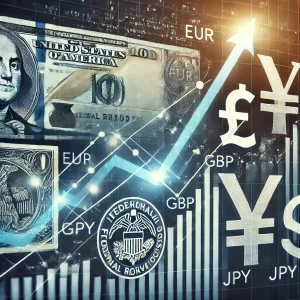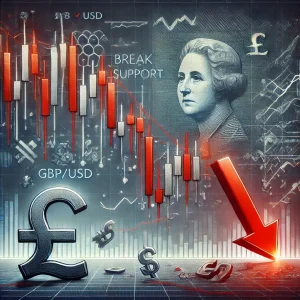Introduction
As the market exhibited the usual holiday-season tranquility and subduedness, the US dollar saw a small drop in value on December 26, 2024. This shift is happening against the background of low liquidity and restricted economic activity, which are common during the end-of-year periods when traders tend to step back from trading. Our investigation of the dollar’s depreciation, its wider market ramifications, and possible future patterns for the most traded currency in the world continues in this piece.
The Setting Of The Fall
Due to major financial hubs operating at reduced hours or being closed, trading volumes tend to be lower towards the end of the calendar year. Every year around this time, the Christmas season dampens the trading mood. Therefore, the weak performance of the US dollar on December 26 mirrored these gloomy conditions. There are a number of fundamental variables that contributed to the dollar’s minor depreciation, though, beyond the seasonal slowdown.
In the weeks preceding the holidays, the US economy’s data releases sent conflicting signals regarding its health. A number of labor market indicators pointed to a possible slowdown in employment growth, even if inflation looked to be moderating. The dollar’s valuation is heavily influenced by the Federal Reserve’s future monetary policy stance, and these contradictory signals have sparked concern about that posture.
Difficulty With Market Attitude And Liquidity
Market sentiment and liquidity problems during holiday-thinned trading are mostly to blame for the US dollar’s drop. Since many large-scale traders were on vacation, retail investors and automated trading algorithms took center stage in the market. Price fluctuations and overreactions to little market signals are common outcomes of this diminished engagement.
In the run-up to the new year, investors seemed wary as well, opting to keep assets with reduced risk or rebalancing their portfolios to reduce their exposure to market volatility. As a result of this risk-averse attitude, demand for other major currencies, such the euro and the yen, rose relative to the dollar, which weakened the dollar even further.
The Influence Of International Finance On The US Dollar
The US dollar is still quite vulnerable to global economic and geopolitical shifts. With the Eurozone’s growth showing no signs of abating, the currency has a firmer foundation thanks to rising industrial production and falling inflationary pressures. The dollar has been under more pressure due to the rising demand for the yen, which has been caused by Japan’s economic stimulus efforts.
The slight rally in crude oil prices over the holiday break also contributed to an increase in the value of the currencies of oil-exporting nations. When oil prices rise, commodity-linked currencies such as the Russian ruble, Canadian dollar, and Norwegian krone tend to gain popularity among traders, which in turn weakens the dollar. On December 26, the dollar had more difficulties as a result of these worldwide concerns.
Economic Implications Of Federal Reserve Actions
There is still a significant amount of dependence on monetary policy on the value of the dollar. The signals that the Federal Reserve has been sending out regarding the possibility of a stop in rate hikes have been closely monitored by investors. In spite of the fact that the Federal Reserve has aggressively raised interest rates during the year 2024 in order to combat inflation, there has been discussion on the possibility of a finish to the tightening cycle. This is because there are signs that the economy is beginning to stabilize.
If the interest rate gap between the United States dollar and other major currencies were to get smaller as a result of such a delay, then foreign investors who are looking for yield benefits would be less inclined to invest in the United States dollar. The dismal performance of the dollar was undoubtedly at least partially attributed to the fact that speculators were anticipated to be prepared for a potential policy shift in twenty-five years.
Dollar Movement Technical Analysis
There was a small retracement on December 26th in the technical analysis of the dollar index (DXY), which compares the value of the dollar to a group of major currencies. The fact that important support levels were tested and maintained steady indicates that the drop did not signal a larger trend reversal. While momentum indicators such as the Relative Strength Index (RSI) suggested a neutral position, moving averages suggested that consolidation would continue.
Even though the dollar is temporarily weak, experts predict that it could recover in early 2025 when trade activity returns to normal. In any case, the direction will be dictated by the Federal Reserve’s policy pronouncements and forthcoming economic statistics.
Looking Ahead To 2025: Obstacles And Possibilities
The future of the US currency is uncertain as we enter the year 2025. A strong basis for future gains is provided by the US dollar’s standing as a safe-haven currency and the resiliency of the US economy. However, the dollar’s strength could be threatened by factors outside its control, such as escalating geopolitical tensions, changes in trade policy, and the revival of competitor economies.
The currencies of emerging markets are particularly vulnerable to changes in the value of the dollar, so this is another area to keep an eye on. Economic stability in emerging areas could be enhanced if nations with dollar-denominated debt were to benefit from any sustained decline in the value of the dollar.
Conclusion
A small drop in the value of the US dollar on December 26, 2024, highlights the complex network of variables that impact currency markets. It would be remiss of us to overlook larger economic and geopolitical trends, even though the holidays certainly had a part in reducing trading activity. The dollar’s future course will be determined, in large part, by the dynamics between market mood, global economic recovery, and Federal Reserve policy.
Traders and investors should keep a sharp eye on the markets as they enter twenty-five. If you want to succeed in the foreign exchange market, you need to keep an eye on important economic indicators and read up on central bank policies. There can be little doubt that the US dollar’s performance will have far-reaching consequences, given its status as the world’s reserve currency.



